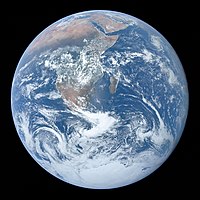
Photo from wikipedia
Cosmochemistry Meteorites are rocky debris left over from the formation of the solar system, which later fall to Earth. Kruijer et al. measured tungsten and molybdenum isotope ratios for a… Click to show full abstract
Cosmochemistry Meteorites are rocky debris left over from the formation of the solar system, which later fall to Earth. Kruijer et al. measured tungsten and molybdenum isotope ratios for a variety of iron meteorite groups and showed that they separate into two sequences—just like stony meteorites are already known to do. Because iron meteorites require parent bodies that grew massive enough to form metal cores, this dichotomy implies two separate regions in the early solar system where planetesimals formed. The authors speculate that the two reservoirs were respectively within and outside the orbit of Jupiter. If that is correct, the giant planet must have formed rapidly, before the meteorite parent bodies did. Proc. Natl. Acad. Sci. U.S.A. 10.1073/pnas.1704461114 (2017).
Journal Title: Science
Year Published: 2017
Link to full text (if available)
Share on Social Media: Sign Up to like & get
recommendations!